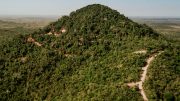The eponymous hero of Joseph Conrad’s novel Nostromo is an “incorruptible” Italian entrusted by the English owner of a silver mine with safeguarding its riches. The setting is the fictional South American country of Costaguana, where all is not well. A revolutionary power has seized control of the capital and is keen, for good measure, to secure the silver as well. To prevent this, Nostromo is instructed to smuggle the silver out of country, to be sold abroad. All does not go to plan, however, when Nostromo’s ship is sunk. Fortunately, Nostromo and the silver make it onto a lifeboat, and our not-so-incorruptible hero proceeds to hide the ingots offshore (literally) on a deserted island for himself.
Conrad might as well have been describing the world of contemporary international mining disputes, which share a number of the same essential ingredients as his novel: the lure of riches in faraway places; political instability; unsavoury characters; stolen assets; and offshore havens. This is a world that is all too familiar to a number of players in the Canadian mining industry.
Just recently, subsidiaries of B.C.-based Pacific Wildcat Resources filed a claim with the International Centre for Settlement of Investment Disputes (ICSID) against Kenya, after the state allegedly revoked their licences to extract rare earth minerals at a location near Mombasa. The timing was conspicuous — news of the revocation came several days after Pacific Wildcat announced the presence of large deposits at the site.
In August 2014, Vancouver-based Bear Creek Mining filed an ICSID claim against Peru over the alleged revocation of its rights to a silver mine (silver mining ventures go wrong in real South American countries, too). The case is pending while the list of analogous disputes around the world — from Kyrgyzstan to Venezuela — grows.
We track these kinds of disputes very closely at my firm. As co-head of Burford Capital’s global intelligence, asset tracing and enforcement business, I find there are two types of mining disputes that generally cross my desk: pre- and post-judgment.
It’s well known that companies involved in ICSID claims often require outside financing given the cost and complexity of pursuing such matters.
There is also a growing need for advisory services during the pre-judgment phase of disputes. The goal is to develop intelligence in support of ongoing legal proceedings and, crucially, clarify any concerns about the recoverability of an award once it is handed down.
Often, the first enforcement strategy in a standard commercial dispute is to freeze any interest in assets at the core of the dispute itself, such as real estate, ships, liquid funds, etc.
When mining assets have been expropriated that is usually not a realistic option, and a miner is thrown straight into the more challenging requirements of cross-border asset tracing and recovery.
Post-judgment, companies are finding that significant investment is often required to enforce an award. For example, Canadian miner Khan Resources recently raised $2 million through a private issue of shares to enforce its $104-million award against Mongolia.
For mining companies, recovery work against sovereign states poses unique challenges. The hurdles facing Western mining companies that have secured judgments in investor-state disputes include the gradual realization that a judgment is not always “as good as gold,” as some states feel no pressure to settle a debt.
Strategies to overcome such intransigence include seizing state-owned assets in jurisdictions amenable to enforcement. The attitude of a foreign government official can change very quickly after he or she learns funds in their New York and Swiss bank accounts have been frozen on the same day.
Other major challenges stem from issues of sovereign immunity, as well as the inconvenient fact that major assets linked to a state (mines, licences, infrastructure) tend be owned by state-owned companies, which have a separate corporate personality. The ability to pursue the assets of state-owned companies as part of the enforcement of a judgment against a state depends on the strength of the connection you are able to make between state and company. The murky company structures involved only make this work more challenging.
Returning to our friend Nostromo, whose treachery goes unnoticed and unpunished for many years, his story offers a sobering lesson: asset recovery work is difficult and there are no quick fixes, all the more so in the context of mining disputes.
It is, nonetheless, worth the fight given the right tools. Although (spoiler alert) perhaps not the shotgun that ultimately ends Nostromo’s winning streak at the end of the novel.
— Daniel Hall is a director and co-head of Burford Capital’s global corporate intelligence, asset tracing and enforcement business. Having graduated from Oxford University with a degree in law, he is a U.K.-qualified solicitor who practised in both London and Hong Kong for Stephenson Harwood. After leaving the law, he enjoyed a number of years in the investigative sector, latterly as a partner at a leading global risk-management consultancy. He spent 10 years investigating fraud and financial crime before founding Focus, and has particular experience in sovereign disputes.
With offices in the U.S. and the U.K. — including New York and London — Burford Capital works with businesses to finance their legal fees and expenses, monetize claims, transfer risk, provide operating expenses or acquire judgments. Burford also serves as an investment banker to law firms to fund case expenses, offer risk sharing solutions, and provide working capital. Please visit www.burfordcapital.com for more information.






Be the first to comment on "Commentary: Finding the hidden silver: Asset tracing and recovery in mining disputes"